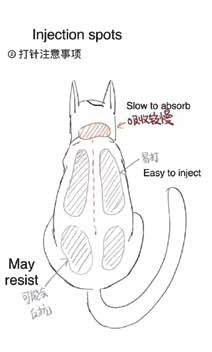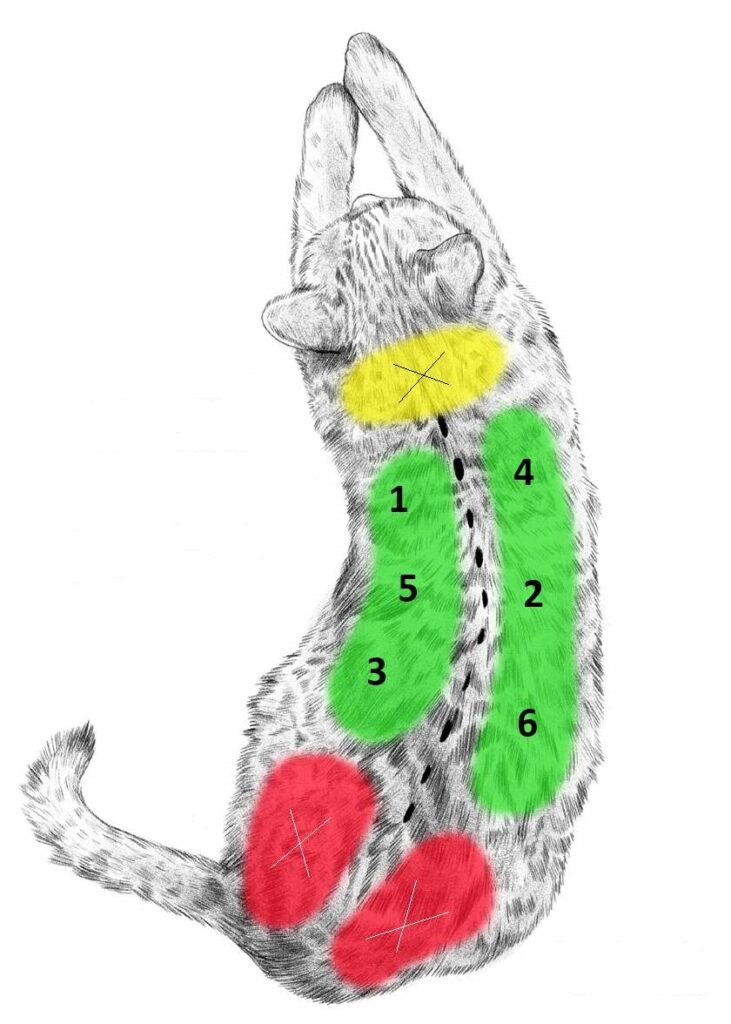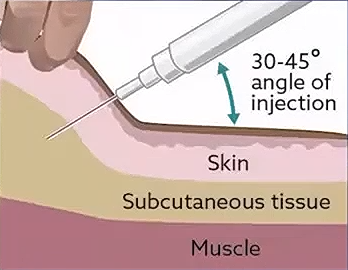FIP Treatment
Before starting treatment
It is recommended to treat FIP for 84 days. Pay special attention to cats with the wet form of FIP and fluid in the pleural (chest) cavity. If fluid builds up there, the cat may have trouble breathing, the heart is very stressed and there is a risk of imminent collapse. It may be necessary to suction out some of the fluid before starting treatment. The increase in the volume of fluid in the chest cavity may be so rapid that the cat may not live to see the effects of the treatment take effect. However, no more than 1/3 of the effusion volume should ever be aspirated. Abdominal effusions are not aspirated at all unless they obstruct breathing.
Choose form of medicine
INJECTIONS
Pros
- Price. Most of the injectables are significantly less than the oral form
- Precision in dosing. You can adjust the daily dose to the exact weight of the cat, whereas the oral form is dosed based on weight range.
- Medicine is not dependent on the digestive system and is fully absorbed into their blood stream, so they are guaranteed to be getting the maximum benefit of the GS.
- The field study was completed using injectable, so there is professionally curated data available.
Cons
- Injections sting and some cats do not tolerate the pain well.Please note that “painless waterbased injections” sold by some Chinese counterfeit drug manufacturers actually contain excessive doses of EIDD-2801 or meloxicam, a drug that can cause kidney failure if you inject once a day.We highly condemn this behavior and promise that these substances will not exist in the GS-441524 injections we manufacture or sell.
- Injection site sores are likely going to happen, regardless of how carefully the shots are administered. In most cases, the sores will heal on their own with little to no need for intervention.
PILLS
Pros
- Ease of administering. Many cats will take the capsules/tablets willingly if coated with a treat or given in a pill pocket.
- The oral forms are readily available at all times.
Cons
- The price. The oral form is more expensive than the injectable form.
- The dose is not accurate. It adjusts in steps, depending on how you are ablet to split the tablet. The dose remains constant within a specific weight range.
- If the cat has gastrointestinal problems, absorption of the drugs is questionable at best. The cat may vomit the tablets or there may be a problem with absorption in the gut.
- Lack of data. There are no field studies for the oral form, so no confirmed data.
Determining the correct dosage
Dosage depends on the form of FIP. Indicative dosage for the given form of FIP can be found in dose calculator . The dose of the medicine is then of course related to the weight of the cat. During the treatment, it is necessary to continuously feed the cat to weigh(at least once a week), and adjust the dose accordingly. It is good if you get into the habit of recording the course of treatment in any form of treatment protocol, where you will write down the weight, temperature, dose of medicine and notes on the clinical condition of the cat.
If the weight of the cat is temporarily reduced, the dose is not reduced. Short-term weight loss may be due to loss of effusion fluid.
There may be a worsening of the condition, or an outbreak of neurological or ocular FIP, and you will be forced to increase the dose. However, in case of deterioration during treatment, it is always good to visit a veterinarian, because FIP is very often accompanied by secondary infections and these are treated with antibiotics.
Please do not confuse dosing in mg / kg and ml / kg!!! The dosage in mg/kg is independent of the drug concentration and expresses the amount of active substance per 1 kg body weight of the cat. The dosage in ml/kg, on the other hand, is specific for the solution for injection solution and depends on its concentration. It expresses the volume of solution you apply per 1 kg of live weight. Dosage conversion in mg/kg vs. ml/kg according to the concentration of the solution for injection can be found in the following table.
| Concentration | Wet 6mg / kg | Dry 8mg / kg | Ocular 10mg / kg | Neuro 12mg / kg | Relapse 15mg/kg |
| 15 mg / ml | 0.4 ml/kg | 0.53 ml/kg | 0.67 ml/kg | 0.8 ml/kg | 1 ml/kg |
| 20 mg / ml | 0.3 ml/kg | 0.4 ml/kg | 0.5 ml/kg | 0.6 ml/kg | 0.75 ml/kg |
It should be noted that the above dosages are for guidance only. Determining the correct dosage is extremely important, especially at the beginning of treatment, when it is necessary to reverse the course of the disease. The dose may also depend on the age of the cat. It also depends on whether it is a classic treatment or a treatment of relapse. In case of relapse, a dose at least 2-5 mg / kg higher than in the previous round of treatment is recommended.
GS-441524 application interval
Medicines, whether in injectable or tableted form, are given every 24 hours. Choose a time that you will be able to adhere to throughout the treatment. For some tablets, or even for small kittens, it is sometimes better to divide the application into two daily doses.
For neurological dosing or even in severe cats, it is also possible to consider splitting the dose into two per day. Especially with tablets, there is a so-called ceiling effect when the absorption capacity of GS441524 in the small intestine may decrease at doses above 10 mg / kg. It often happens that the desired effect does not occur when the drug is administered once a day, but when the dose is divided into two days, the situation is significantly improved.
Supportive treatment
Hepatopretics (eg Liv 52, Denosyl, Denamarin) and probiotics (eg Fortiflora) should also be given to cats during treatment, and B12 in case of severe anemia.
Cats with FCoV or FIP should never be given lysine, as it is antagonistic to arginine, which is essential for immune function. Additionally, lysine may potentially impact the effectiveness of GS-441524.
How long will it take to see if the treatment works
In some cases, the treatment will take place almost immediately, the cat’s temperature will return to normal, he will start to be more active, he will start eating… Most cats will respond to the treatment within 2 days. With wet FIP, most of the fluid should normally be absorbed within 7-14 days. Either way, the therapeutic effect of any form of FIP in terms of improving the clinical condition, if you have the right dosage, you should notice a maximum of about 3-4 days. If this does not happen, it is time to think about changing the medicine or its form (eg from tablets to injections or vice versa) or increasing the dose. However, it is possible that the cat also suffers from another associated health problem that you will have to deal with with a veterinarian. FIP is often accompanied by other diseases and maybe your cat will need ATB, for example.
If the treatment does not work within 4 days, or even the cat’s condition worsens, it is possible that it is not FIP at all and you should deal with this situation quickly. The danger of concentrating too much on FIP, even if the treatment does not seem to work, is that you may miss the real illness your cat is suffering from, and as a result may die just because you do not know about it and are not looking for it. If you have a dose of 12 mg / kg or higher, and the cat is not improving or deteriorating, it is almost certain that there is another serious problem than FIP.
Resistance to GS-441524 may also occur rarely, but is very rare during initial treatment and occurs rather in the form of partial resistance to relapse treatment, which can often be overcome by increasing the dose. Complete resistance requires treatment with another active substance, such as molnupiravir.
Treatment by injections
Injections are administered subcutaneously every 24 hours.
Due to the length of treatment, you will need to rotate the injection sites to prevent any skin lesions. At the same time, the injections are quite painful, so it is possible that you will not be able to do without the help of another person. If you have no experience with injections, it is a good idea to arrange with a veterinarian to teach you. Due to the viscosity of the solution for injection, we recommend green needles 0.8x25mm. If the cat behaves aggressively during administration, it is good to wrap it in a blanket, for example, and leave only the places where you want to inject accessible. There are even “burritos” for cats that can immobilize it but also allow you to inject.
Most cats are angry immediately after application to the point that they are best calmed by food. Often, even when the injection becomes a daily ritual, it may happen that when you give the cat a bowl of food, you can inject it during feeding so that the cat almost does not notice.
Injection site sores are cleared of surrounding hair and gently cleaned 4 or more times a day with sterile cotton balls soaked in 1:5 dilution of household hydrogen peroxide. They usually do not require any more sophisticated treatment and heal within 2 weeks or so.
General how-to for injection administration can be found below.



WHAT TO LOOK OUT FOR WHEN INJECTING
The GS solution is very acidic. As a precaution against lesions or necrosis of the skin at the injection site, it is important to always inject with a clean needle and at least wipe the site with water moistened with gauze / cloth (neutralize) after application. Be careful not to get too much injection site and keep track of how much GS may have leaked.
If GS leaks a lot, it is advisable to consider repeating the application to maintain the dosage. If GS leaks from the injection site, it may be due to the volume of solution being applied, the needle being not inserted deep enough, or the needle diameter being too large. If possible, apply the GS solution slowly and slowly pull the needle out of the injection site.
After injection, slight bleeding may occur due to damage to the subcutaneous tissue. If it is just a few drops, it is a relatively common and unproblematic condition that does not require urgent veterinary care. If the bleeding is heavy or the cat behaves unusually painfully after GS application (especially for an atypical manifestation of pain that lasts for more than a few minutes after application), it moves uncoordinated, has difficulty breathing or is paralyzed, it is time to seek urgent veterinary care!
When calculating the GS dose, it is recommended to round to the nearest higher tenth.
Treatment with pills
Administration of tablets usually takes place without any problems. The tablets should be given on an empty stomach and you should make sure that the cat drinks enough. But there are cases when you will have to give the cat tablets with food for some reason. It doesn’t even matter. If you vomit within 2 hours of taking the tablet, you may need to take the tablet again. I recommend reading the following article.
Regular check-ups by a veterinarian
In order to possibly adjust the dose during treatment and to avoid prolongation, or to minimize the risk of possible relapse after treatment, it is a good idea to have a haematological and biochemical blood test during treatment, ideally at weeks 4 and 8. Treatment that is developing in the right direction has been shown to return gamma globulins to a reference range by the end of treatment.
End of treatment
Just before the end of the treatment (84) days, it is good to have the blood examined and according to the results, taking into account the clinical condition of the cat, to decide on its termination or extension. In addition to the classic hematological and biochemical examination, it is good to have plasma protein electrophoresis performed, which will provide much more accurate results. This is followed by a 3-month period, the so-called PostTreatment. When this period has passed without relapse, the cat can be declared cured.
At the end of treatment, the following values should be normal:
- albumin
- globulins
- A/G ratio > 0.7
- bilirubin
- lymphocytes
- neutrophiles
- hematocrit, hemoglobin, erythrocytes
- gamaglobulins (from electrophoresis)
Post-Treatment Period
The end of the treatment is followed by an observation period of 12 weeks. During this period, it is good to give the cat peace and protect it from stressful situations. It is recommended to take control blood samples at least in the 12th week. After the end of the observation period, the cat can be considered cured.
Relapse
Sometimes, despite the best efforts, it happens that FIP returns during the post-treatment period, the so-called relapse, and mostly appears in a neurological form. The reason is usually that the virus has entered the nervous system and a much higher dosage, at least 15mg/kg of GS-441524, will be required for treatment. It is also often typical for the neurological form of FIP in a relapse that the blood results are normal. Relapse treatment should last at least 8 weeks, and if finances allow, 12 weeks.